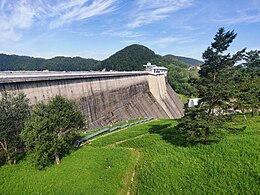Solina Dam
| Solina Dam | |
|---|---|
 Aerial view of the dam | |
| Country | Poland |
| Location | Solina |
| Coordinates | 49°23′44.03″N 22°27′11.65″E / 49.3955639°N 22.4532361°E |
| Purpose | Power |
| Status | Operational |
| Construction began | 1960 |
| Opening date | 1969 |
| Dam and spillways | |
| Type of dam | Gravity |
| Height | 81.8 m (268 ft) |
| Length | 664.8 m (2,181 ft) |
| Width (crest) | 8.8 m (29 ft) |
| Dam volume | 760,000 m3 (990,000 cu yd)[1] |
| Reservoir | |
| Creates | Lake Solina |
| Total capacity | 472,000,000 m3 (383,000 acre⋅ft) |
| Surface area | 22 km2 (8.5 sq mi) |
| Commission date | 1968 |
| Hydraulic head | 60 m (200 ft)[2] |
| Turbines | 2 x 73 MW Francis-type, 2 x 27 MW reversible Francis turbines[3] |
| Installed capacity | 200 MW |

The Solina Dam (Polish: Zapora Solińska) is a concrete gravity dam in south-eastern Poland. It is the largest dam in the country. It is located in Solina of Lesko County in the Bieszczady Mountains area of Poland. With the completion of the dam in 1968, Lake Solina, the largest artificial lake in Poland, was created.
History
The San river which runs through the area has a large flood plain and a series of floods prompted the consideration of a dam to regulate the water flow. The first plans for a dam in the region came in 1921 and called for a small dam in Myczkowce. The project was slow to begin and with the start of World War II it was put on hold. After the war ended the plans were revised and now included a larger dam in Solina. Various work began in 1953 and the smaller Myczkowce Dam downstream, which would become a supporting dam, was completed in the years 1956-1960. In 1960 work began based on a design by Feliks Niczke of Energoprojekt Warszawa. The construction was completed in 1968 and cost 1.5 billion of 1968 zlotys. 57 km (35 mi) of roads were also constructed as part of the project.[4]

The dam
The dam is 664 m (2,178 ft) long, 8.8 m (29 ft) wide at the crest, and 81.8 m (268 ft) high. An estimated 820,000 cubic meters of cement was used for the construction of the dam, which weighs 2 million tonnes.[5] Its construction created the largest artificial lake in Poland – Lake Solina. It has four turbines which were initially capable of generating 136 MW of electricity. As a pumped-storage power station, two of the turbines can also reverse flow and send water from the Myczkowce Dam's reservoir back into the Lake Solina for use during peak periods, optimizing power generation. Starting in 1995 efforts have been made to modernize the power plant. The installation of new technologies between 2000 and 2003 and the replacement of the old turbines resulted in the dam currently generating 200 MW of electricity as opposed to 173 MW previously.[4]
The Solina dam is an important tourist attraction of the area. Tours are available and the dam serves as a bridge to the Lake Solina marina.
See also
References
- ^ "FIREWALL in Solina" (in Polish). PGE Energy. Archived from the original on 26 February 2014. Retrieved 21 February 2014.
- ^ "Solina Pumped Storage Power Plant" (PDF). Sandia National Laboratories. Retrieved 21 February 2014.
- ^ "Pumped-Storage Hydroelectric Plants in Poland". IndustCards. Archived from the original on September 9, 2013. Retrieved 21 February 2014.
{{cite web}}: CS1 maint: unfit URL (link) - ^ a b Kamil Mielnikiewicz (20 July 2024). "Zapora wodna w Solinie ma już 56 lat. Jak powstała ta budowla? [ZDJĘCIA ARCHIWALNE, WIDEO]". wbieszczady.pl (in Polish). Retrieved 17 August 2024.
- ^ Tomasz Pogoda (20 July 2020). "52 lata temu uruchomiono zaporę w Solinie. Historia powstania Jeziora Solińskiego". dobrapogoda24.pl (in Polish). Retrieved 17 August 2024.
External links
![]() Media related to Solina Dam at Wikimedia Commons
Media related to Solina Dam at Wikimedia Commons

